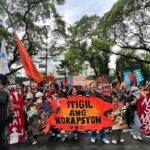Contents
AFTER a year of restrictions on business operations and social activities all over the country because of the COVID-19 pandemic, we are now beginning to talk of economic recovery. In the last 12 months, the country has been placed under various levels of restrictions, starting with the most restrictive Enhanced Community Quarantine (ECQ) in Metro Manila on March 16, 2020.The restrictions were gradually eased as the COVID-19 infections and deaths were brought down. We are now under General Community Quarantine (GCQ) in Metro Manila, possibly easing into Modified GCQ this coming March. This would be the final step before lifting of all restrictions.During all this time, most business enterprises and offices were closed down and people were told to stay home, all in an effort to minimize the gathering of people that allows the COVID-19 virus to jump from one person to another. This spread of the virus was also blocked to a great extent by the use of face masks and face shields, keeping distance from one another, and constant washing of hands.All this was achieved at the expense of the economy. As businesses and offices closed and people stopped going to work, the national economy slowed down and fell into recession. It was a worldwide phenomenon – social restrictions in the wake of so many deaths, followed by a breakdown of the economy. The world is now beginning slowly to recover, with some nations undertaking the mass vaccination of their people.We too have begun to talk of national recovery, but the nation’s employers are more cautious in their assessment of the situation. Officials of the Employers Confederation of the Philippines (ECOP) and the Federation of Filipino-Chinese Chambers of Commerce and Industry (FFCCCI) said Monday that the country’s microenterprises, which account for 90 percent of total business in the Philippines, are now beginning to reopen.But at the present rate at which the economy is reopening, they said, recovery may actually start only next year, in 2022. The government still does not allow all public mass transportation, so many workers still cannot report for work. The ECOP and FFCCCI also asked why projects such as jeepney modernization, motor vehicle inspection, and car seats for children were being pushed when these mean additional costs to both companies and the people.It is truly a delicate balancing act that the government is now doing, with every easing of restriction followed by some rise in the number of infections and deaths. Hopefully, the situation will improve as the vaccination begins. But even that remains uncertain, as the supplies we expect are far below what we need for our 110-million people to achieve so-called “herd immunity.”Ultimately, we must rely on the individual care we have come to adopt in these past several months. And we may have to accept that under the circumstances, as the ECOP and FFCCCI officials said early this week, economic recovery may come only in 2022.

AFTER a year of restrictions on business operations and social activities all over the country because of the COVID-19 pandemic, we are now beginning to talk of economic recovery. In the last 12 months, the country has been placed under various levels of restrictions, starting with the most restrictive Enhanced Community Quarantine (ECQ) in Metro Manila on March 16, 2020.
The restrictions were gradually eased as the COVID-19 infections and deaths were brought down. We are now under General Community Quarantine (GCQ) in Metro Manila, possibly easing into Modified GCQ this coming March. This would be the final step before lifting of all restrictions.
During all this time, most business enterprises and offices were closed down and people were told to stay home, all in an effort to minimize the gathering of people that allows the COVID-19 virus to jump from one person to another. This spread of the virus was also blocked to a great extent by the use of face masks and face shields, keeping distance from one another, and constant washing of hands.
All this was achieved at the expense of the economy. As businesses and offices closed and people stopped going to work, the national economy slowed down and fell into recession. It was a worldwide phenomenon – social restrictions in the wake of so many deaths, followed by a breakdown of the economy. The world is now beginning slowly to recover, with some nations undertaking the mass vaccination of their people.









